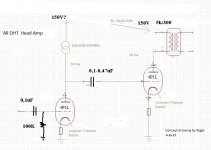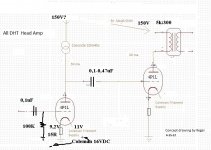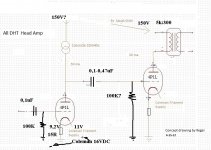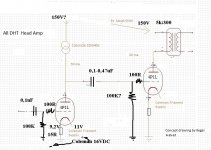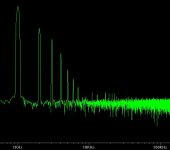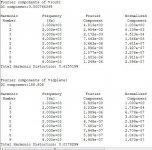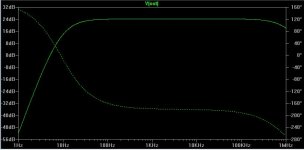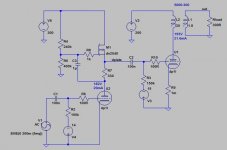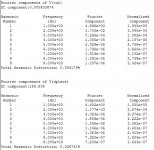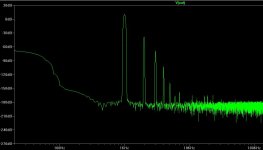I know one person in Spain how makes hand made grain orientated, can't be enough? what about Lundhal LL1689 http://www.lundahl.se/pdf/1689.pdf, can be wired 9:1 or 18:1?
I think Lundhal C-core is what I am leaning toward since they have less signal loss, with senns and grados we are dealling with small millwatts and detail is lost without the right transformer, all I can say is don't go for a transformer with high DCR secondary, it makes the output tube work and distort way more than it has too. I honestly know just enough about transformer design to be dangerious, but none of us set headphone geeks have pooled our resources to find the right transformer winder who uderstands our needs.
As much as I like the single -feed design I proposed I suspect that a parafeed nckel core OPT would sound better, just don't have the answers for you unfortunately.
The real classic headphone iron is the Peerless TL-404 autoformer parafeed, but they are hard to find. If enough of us asked magnequest perhaps they would make a batch.
Maybe some of the preamp guys can share some light on the subject ?
Regular C cores from Silicon Steel C-Cores / Goss C-Cores for 60 Hz and 50/60 Hz Frequencies wouldn't work?
Resistor from grid of second tube to ground needed. I'd also add grid stopper resistors to safeguard against oscillations.
Grid stopper resistors in both tubes? wich value & power?
Attached updated schematic.
Attachments
No, you don't. Try first.
Hmmm... somewhat abrupt response ?
Yes well actually I do know which I'd prefer , because I was recently building a phono amp with various set-up options from a JFET/triode cascode on the front end . At the same time a good friend of mine built an exact equivalent of the set-up in a test rig and measured it with an Agilent spectrum analyser . It was very clear that the front-end sounded a lot better with some 2nd-harmonic at -70dB, than it sounded with the device set-up adjusted to give no measurable distortion.
I've had experiences that back-up this sort of conclusion in the SE amps I've built over the years plus measurements made on PP Class A DHT amps I built back in 2003 , where we used ( and tested ) it with and without the Western Electric 'harmonic equalizer' tweak .
The extent to which one would want some or no 2nd harmonic would be dependant on the system and the individual , but I agree that one should certainly 'try first' and also trust your ears . With 3rd and higher-orders, I think most people would prefer the lowest values you could get.
Hmmm... somewhat abrupt response ?
Yes well actually I do know which I'd prefer ,
It is actually what I meant.
Some people believe that others prefer tube amps because of added distortions, despite experiments don't prove that. You can't model result of absense of nasty distortions adding something that is irrelevent. Like water from a glass cleaned by gasoline may look better than from glass cleaned by water that contained some clay, but it will not taste better. Adding to the glass of water cleaned by gasoline a bit of clay you can't improve it's taste.
Last edited:
Roughly, this is how this simulates with the 4p1l model I have. No filament starving tricks here and operating points chosen in a hurry. Assumed 300mV p-p input, output 10V p-p, which for this circuits translates to about 90mW.
Attachments
Some people believe that others prefer tube amps because of added distortions, despite experiments don't prove that. You can't model result of absense of nasty distortions adding something that is irrelevent. Like water from a glass cleaned by gasoline may look better than from glass cleaned by water that contained some clay, but it will not taste better. Adding to the glass of water cleaned by gasoline a bit of clay you can't improve it's taste.
I'm not sure I fully understand your response , but I still think I disagree with you entirely ;o)
Of course we are not really talking about clay and gasoline here, it's about the fine balance of the first 3 or 4 distortion products in a SYSTEM and how that renders musical information such as instrument timbre and the realism of voices . There are a number of potential reasons why a audio system might have more third than second harmonic - in that case a pre-amp might the the perfect place to address that problem and add some correcting 2nd harmonic . As I said above, it might only be the difference of something at the -60 to -70dB level from the main signal ; but the human ear is very sensitive to these things.
The 4P1L is a very interesting valve in this regard , as you can run it in several different ways . For instance if you wanted some extra 2nd harmonic, you could run it as a pentode with a lowish anode load of 2 or 3k .
I have 100R 1/2W, updated attached pic, the pic is OK now?
Thanks for cleaning up my skimpy schematic, but 150V B+ is much too low.
Good operating point for this tube is 200-230V 30mA.
So that means you have a B+ of about 275V for the first tube with the CCS or gyrator, then use an extra RC to give the 200V B+ for the second tube.
I have 4 of the 4p1l's and am determined to build this when I finish this DAC B.S. But I am on the fence between Grados, Senns, and Orthos. So something to keep in mind when you buy your transformer is you might not want to be tied down to only a 300 ohm tap.
Also to add confusion if you read the ecp article linked above about parafeed, you will really get frustrated cause finding a permalloy core custom para-feed transformer is impossible.
A high quality permalloy 5k:300+32 parafeed OPT would be a real nice to have for preamp builders because it would give a nice headphone output. Kill two birds with one stone.
Also to add confusion if you read the ecp article linked above about parafeed, you will really get frustrated cause finding a permalloy core custom para-feed transformer is impossible.
This shoudn't be a big problem, have you considered Dave Slagle at Intact Audio ? - this is the sort of thing he's always ready to discuss :
:: Index
- Home
- Amplifiers
- Tubes / Valves
- One more 4P1L SE
